key Alfa Romeo 156 2004 Owner handbook (in English)
[x] Cancel search | Manufacturer: ALFA ROMEO, Model Year: 2004, Model line: 156, Model: Alfa Romeo 156 2004Pages: 357, PDF Size: 5.04 MB
Page 46 of 357
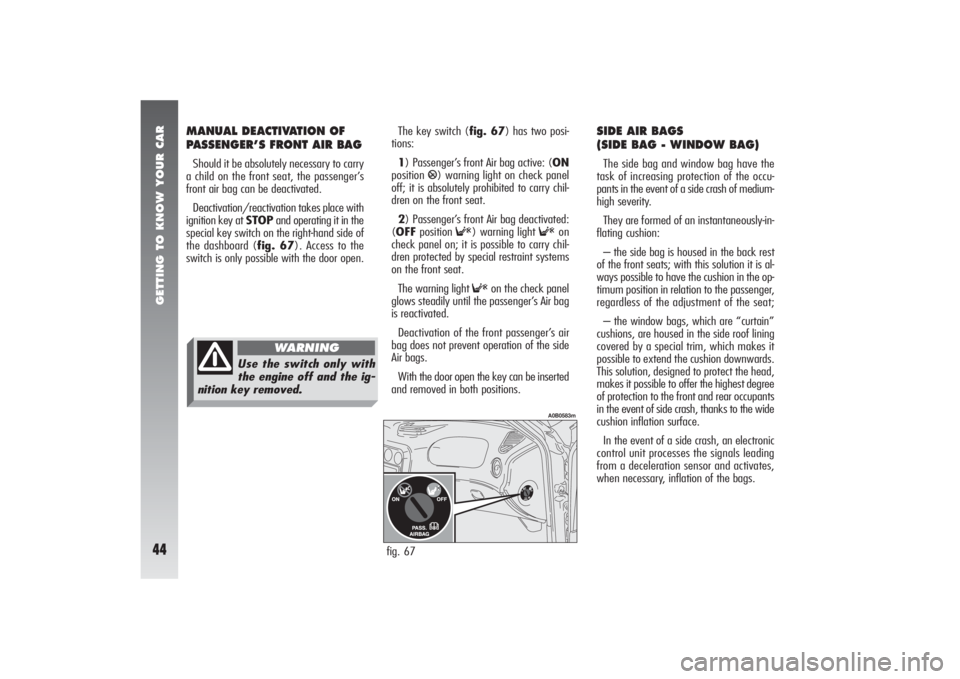
GETTING TO KNOW YOUR CAR44
MANUAL DEACTIVATION OF
PASSENGER’S FRONT AIR BAGShould it be absolutely necessary to carry
a child on the front seat, the passenger’s
front air bag can be deactivated.
Deactivation/reactivation takes place with
ignition key at STOPand operating it in the
special key switch on the right-hand side of
the dashboard (fig. 67). Access to the
switch is only possible with the door open.The key switch (fig. 67) has two posi-
tions:
1) Passenger’s front Air bag active: (ON
position
P) warning light on check panel
off; it is absolutely prohibited to carry chil-
dren on the front seat.
2) Passenger’s front Air bag deactivated:
(OFFposition
F
) warning light
F
on
check panel on; it is possible to carry chil-
dren protected by special restraint systems
on the front seat.
The warning light
F
on the check panel
glows steadily until the passenger’s Air bag
is reactivated.
Deactivation of the front passenger’s air
bag does not prevent operation of the side
Air bags.
With the door open the key can be inserted
and removed in both positions.
SIDE AIR BAGS
(SIDE BAG - WINDOW BAG)The side bag and window bag have the
task of increasing protection of the occu-
pants in the event of a side crash of medium-
high severity.
They are formed of an instantaneously-in-
flating cushion:
– the side bag is housed in the back rest
of the front seats; with this solution it is al-
ways possible to have the cushion in the op-
timum position in relation to the passenger,
regardless of the adjustment of the seat;
– the window bags, which are “curtain”
cushions, are housed in the side roof lining
covered by a special trim, which makes it
possible to extend the cushion downwards.
This solution, designed to protect the head,
makes it possible to offer the highest degree
of protection to the front and rear occupants
in the event of side crash, thanks to the wide
cushion inflation surface.
In the event of a side crash, an electronic
control unit processes the signals leading
from a deceleration sensor and activates,
when necessary, inflation of the bags.
fig. 67
A0B0583m
Use the switch only with
the engine off and the ig-
nition key removed.
WARNING
Page 48 of 357
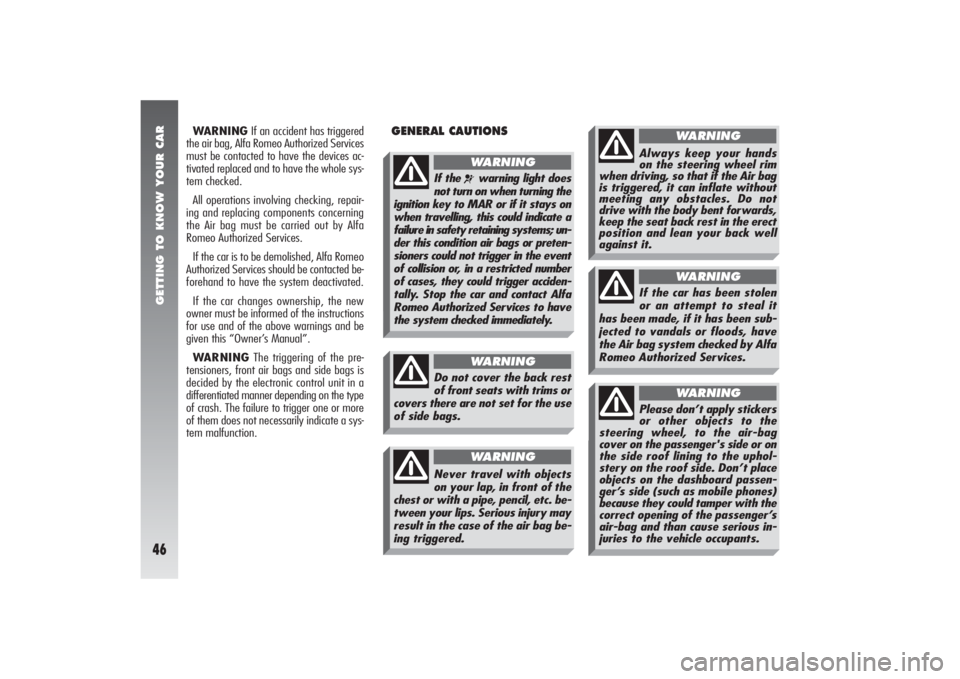
GETTING TO KNOW YOUR CAR46
WARNINGIf an accident has triggered
the air bag, Alfa Romeo Authorized Services
must be contacted to have the devices ac-
tivated replaced and to have the whole sys-
tem checked.
All operations involving checking, repair-
ing and replacing components concerning
the Air bag must be carried out by Alfa
Romeo Authorized Services.
If the car is to be demolished, Alfa Romeo
Authorized Services should be contacted be-
forehand to have the system deactivated.
If the car changes ownership, the new
owner must be informed of the instructions
for use and of the above warnings and be
given this “Owner’s Manual”.
WARNINGThe triggering of the pre-
tensioners, front air bags and side bags is
decided by the electronic control unit in a
differentiated manner depending on the type
of crash. The failure to trigger one or more
of them does not necessarily indicate a sys-
tem malfunction.
GENERAL CAUTIONS
If the
¬
warning light does
not turn on when turning the
ignition key to MAR or if it stays on
when travelling, this could indicate a
failure in safety retaining systems; un-
der this condition air bags or preten-
sioners could not trigger in the event
of collision or, in a restricted number
of cases, they could trigger acciden-
tally. Stop the car and contact Alfa
Romeo Authorized Services to have
the system checked immediately.WARNING
Do not cover the back rest
of front seats with trims or
covers there are not set for the use
of side bags.
WARNING
Never travel with objects
on your lap, in front of the
chest or with a pipe, pencil, etc. be-
tween your lips. Serious injury may
result in the case of the air bag be-
ing triggered.
WARNING
Always keep your hands
on the steering wheel rim
when driving, so that if the Air bag
is triggered, it can inflate without
meeting any obstacles. Do not
drive with the body bent forwards,
keep the seat back rest in the erect
position and lean your back well
against it.
WARNING
If the car has been stolen
or an attempt to steal it
has been made, if it has been sub-
jected to vandals or floods, have
the Air bag system checked by Alfa
Romeo Authorized Services.
WARNING
Please don’t apply stickers
or other objects to the
steering wheel, to the air-bag
cover on the passenger's side or on
the side roof lining to the uphol-
stery on the roof side. Don’t place
objects on the dashboard passen-
ger’s side (such as mobile phones)
because they could tamper with the
correct opening of the passenger’s
air-bag and than cause serious in-
juries to the vehicle occupants.
WARNING
Page 49 of 357
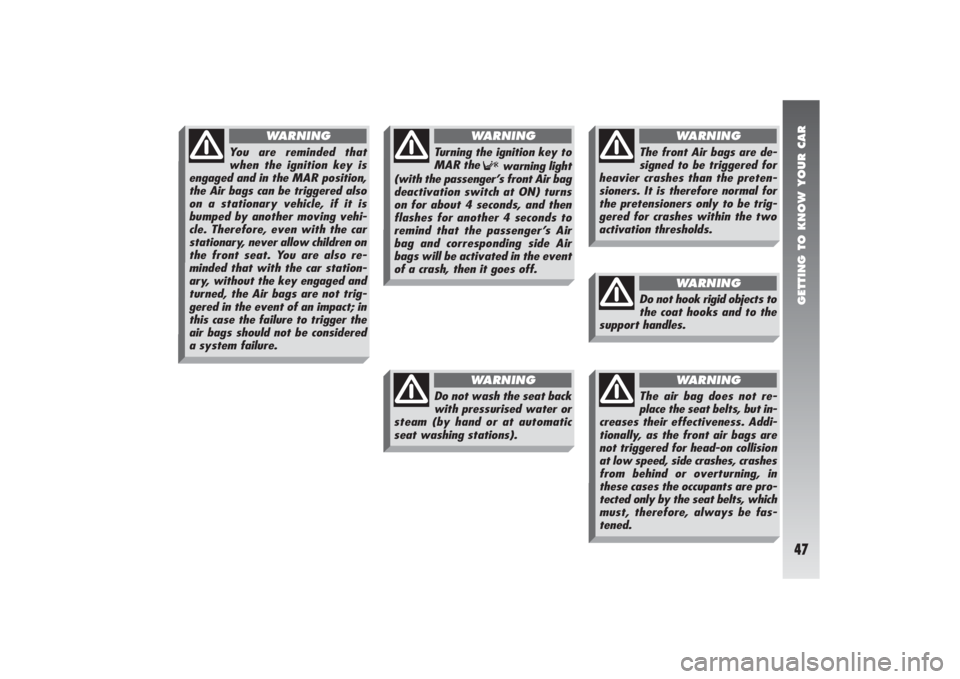
GETTING TO KNOW YOUR CAR47
You are reminded that
when the ignition key is
engaged and in the MAR position,
the Air bags can be triggered also
on a stationary vehicle, if it is
bumped by another moving vehi-
cle. Therefore, even with the car
stationary, never allow children on
the front seat. You are also re-
minded that with the car station-
ary, without the key engaged and
turned, the Air bags are not trig-
gered in the event of an impact; in
this case the failure to trigger the
air bags should not be considered
a system failure.
WARNING
Turning the ignition key to
MAR the
F
warning light
(with the passenger’s front Air bag
deactivation switch at ON) turns
on for about 4 seconds, and then
flashes for another 4 seconds to
remind that the passenger’s Air
bag and corresponding side Air
bags will be activated in the event
of a crash, then it goes off.
WARNING
Do not wash the seat back
with pressurised water or
steam (by hand or at automatic
seat washing stations).
WARNING
The front Air bags are de-
signed to be triggered for
heavier crashes than the preten-
sioners. It is therefore normal for
the pretensioners only to be trig-
gered for crashes within the two
activation thresholds.
WARNING
Do not hook rigid objects to
the coat hooks and to the
support handles.
WARNING
The air bag does not re-
place the seat belts, but in-
creases their effectiveness. Addi-
tionally, as the front air bags are
not triggered for head-on collision
at low speed, side crashes, crashes
from behind or overturning, in
these cases the occupants are pro-
tected only by the seat belts, which
must, therefore, always be fas-
tened.
WARNING
Page 50 of 357
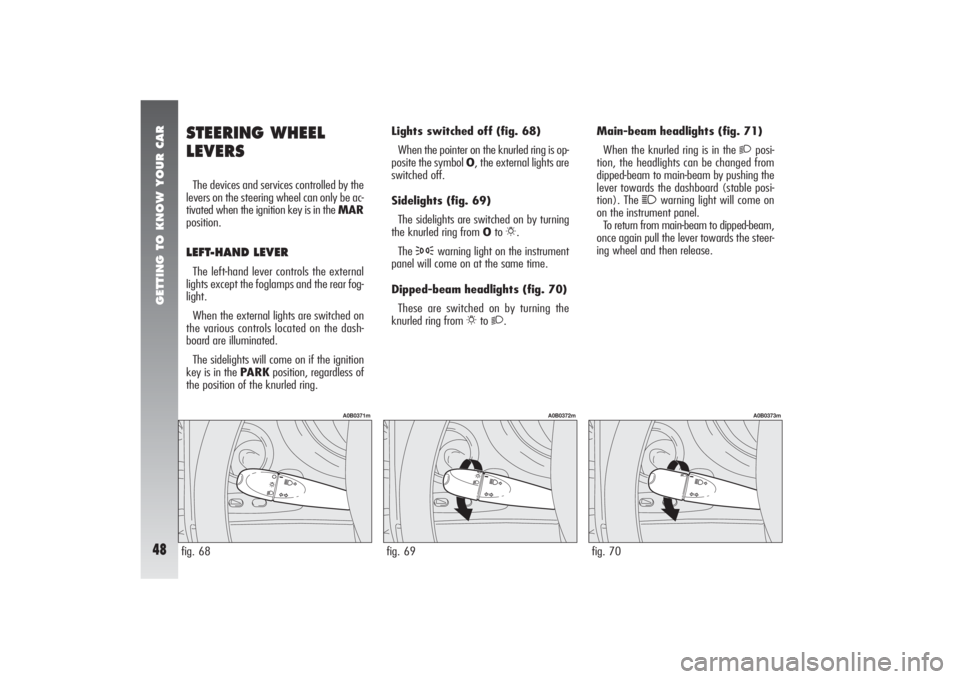
GETTING TO KNOW YOUR CAR48
fig. 70
A0B0373m
STEERING WHEEL
LEVERSThe devices and services controlled by the
levers on the steering wheel can only be ac-
tivated when the ignition key is in the MAR
position.LEFT-HAND LEVERThe left-hand lever controls the external
lights except the foglamps and the rear fog-
light.
When the external lights are switched on
the various controls located on the dash-
board are illuminated.
The sidelights will come on if the ignition
key is in the PARKposition, regardless of
the position of the knurled ring.Lights switched off (fig. 68)
When the pointer on the knurled ring is op-
posite the symbol O, the external lights are
switched off.
Sidelights (fig. 69)
The sidelights are switched on by turning
the knurled ring from Oto
6.
The
3
warning light on the instrument
panel will come on at the same time.
Dipped-beam headlights (fig. 70)
These are switched on by turning the
knurled ring from
6
to 2
.Main-beam headlights (fig. 71)
When the knurled ring is in the
2
posi-
tion, the headlights can be changed from
dipped-beam to main-beam by pushing the
lever towards the dashboard (stable posi-
tion). The
1
warning light will come on
on the instrument panel.
To return from main-beam to dipped-beam,
once again pull the lever towards the steer-
ing wheel and then release.
fig. 68
A0B0371m
fig. 69
A0B0372m
Page 53 of 357
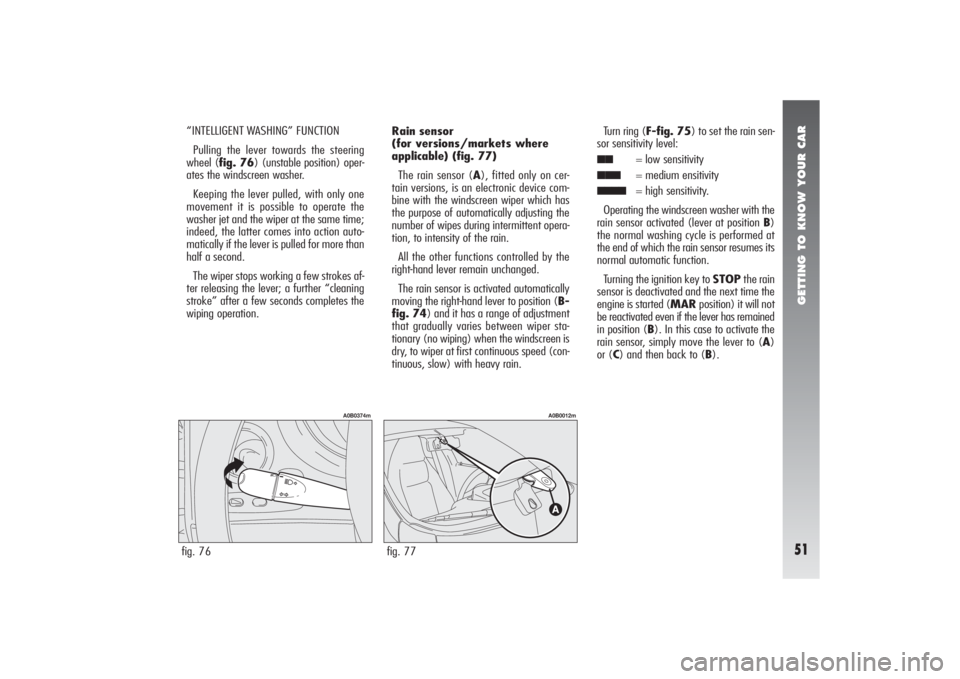
GETTING TO KNOW YOUR CAR51
“INTELLIGENT WASHING” FUNCTION
Pulling the lever towards the steering
wheel (fig. 76) (unstable position) oper-
ates the windscreen washer.
Keeping the lever pulled, with only one
movement it is possible to operate the
washer jet and the wiper at the same time;
indeed, the latter comes into action auto-
matically if the lever is pulled for more than
half a second.
The wiper stops working a few strokes af-
ter releasing the lever; a further “cleaning
stroke” after a few seconds completes the
wiping operation.Rain sensor
(for versions/markets where
applicable) (fig. 77)
The rain sensor (A), fitted only on cer-
tain versions, is an electronic device com-
bine with the windscreen wiper which has
the purpose of automatically adjusting the
number of wipes during intermittent opera-
tion, to intensity of the rain.
All the other functions controlled by the
right-hand lever remain unchanged.
The rain sensor is activated automatically
moving the right-hand lever to position (B-
fig. 74) and it has a range of adjustment
that gradually varies between wiper sta-
tionary (no wiping) when the windscreen is
dry, to wiper at first continuous speed (con-
tinuous, slow) with heavy rain.Turn ring (F-fig. 75) to set the rain sen-
sor sensitivity level:
■■
= low sensitivity
■■■
= medium ensitivity
■■■■
= high sensitivity.
Operating the windscreen washer with the
rain sensor activated (lever at position B)
the normal washing cycle is performed at
the end of which the rain sensor resumes its
normal automatic function.
Turning the ignition key to STOPthe rain
sensor is deactivated and the next time the
engine is started (MAR position) it will not
be reactivated even if the lever has remained
in position (B). In this case to activate the
rain sensor, simply move the lever to (A)
or (C) and then back to (B).
fig. 76
A0B0374m
fig. 77
A0B0012m
Page 56 of 357
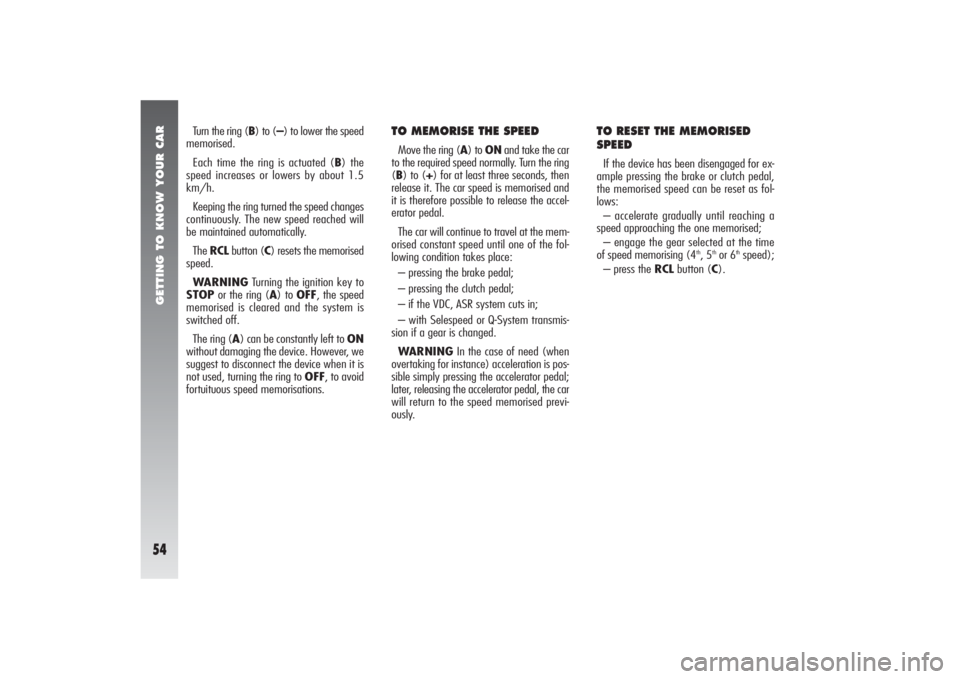
GETTING TO KNOW YOUR CAR54
Turn the ring (B) to (–) to lower the speed
memorised.
Each time the ring is actuated (B) the
speed increases or lowers by about 1.5
km/h.
Keeping the ring turned the speed changes
continuously. The new speed reached will
be maintained automatically.
The RCLbutton (C) resets the memorised
speed.
WARNINGTurning the ignition key to
STOPor the ring (A) to OFF, the speed
memorised is cleared and the system is
switched off.
The ring (A) can be constantly left to ON
without damaging the device. However, we
suggest to disconnect the device when it is
not used, turning the ring to OFF, to avoid
fortuituous speed memorisations.
TO MEMORISE THE SPEEDMove the ring (A) to ONand take the car
to the required speed normally. Turn the ring
(B) to (+) for at least three seconds, then
release it. The car speed is memorised and
it is therefore possible to release the accel-
erator pedal.
The car will continue to travel at the mem-
orised constant speed until one of the fol-
lowing condition takes place:
– pressing the brake pedal;
– pressing the clutch pedal;
– if the VDC, ASR system cuts in;
– with Selespeed or Q-System transmis-
sion if a gear is changed.
WARNINGIn the case of need (when
overtaking for instance) acceleration is pos-
sible simply pressing the accelerator pedal;
later, releasing the accelerator pedal, the car
will return to the speed memorised previ-
ously.
TO RESET THE MEMORISED
SPEEDIf the device has been disengaged for ex-
ample pressing the brake or clutch pedal,
the memorised speed can be reset as fol-
lows:
– accelerate gradually until reaching a
speed approaching the one memorised;
– engage the gear selected at the time
of speed memorising (4
th, 5
thor 6
thspeed);
– press the RCLbutton (C).
Page 64 of 357
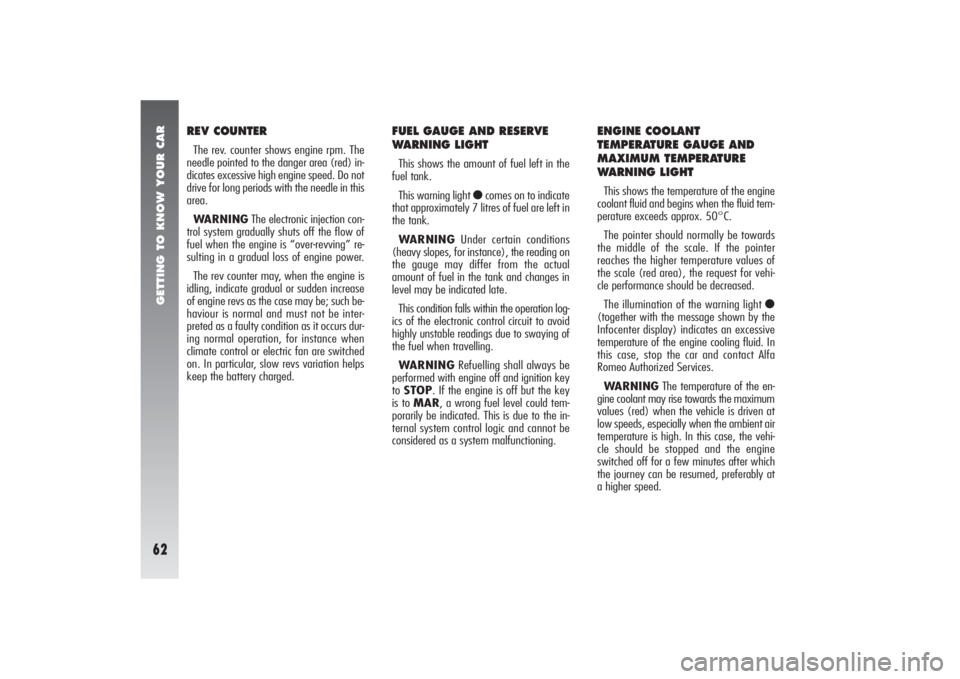
GETTING TO KNOW YOUR CAR62
REV COUNTERThe rev. counter shows engine rpm. The
needle pointed to the danger area (red) in-
dicates excessive high engine speed. Do not
drive for long periods with the needle in this
area.
WARNINGThe electronic injection con-
trol system gradually shuts off the flow of
fuel when the engine is “over-revving” re-
sulting in a gradual loss of engine power.
The rev counter may, when the engine is
idling, indicate gradual or sudden increase
of engine revs as the case may be; such be-
haviour is normal and must not be inter-
preted as a faulty condition as it occurs dur-
ing normal operation, for instance when
climate control or electric fan are switched
on. In particular, slow revs variation helps
keep the battery charged.
FUEL GAUGE AND RESERVE
WARNING LIGHTThis shows the amount of fuel left in the
fuel tank.
This warning light
ç
comes on to indicate
that approximately 7 litres of fuel are left in
the tank.
WARNINGUnder certain conditions
(heavy slopes, for instance), the reading on
the gauge may differ from the actual
amount of fuel in the tank and changes in
level may be indicated late.
This condition falls within the operation log-
ics of the electronic control circuit to avoid
highly unstable readings due to swaying of
the fuel when travelling.
WARNINGRefuelling shall always be
performed with engine off and ignition key
to STOP. If the engine is off but the key
is to MAR, a wrong fuel level could tem-
porarily be indicated. This is due to the in-
ternal system control logic and cannot be
considered as a system malfunctioning.
ENGINE COOLANT
TEMPERATURE GAUGE AND
MAXIMUM TEMPERATURE
WARNING LIGHTThis shows the temperature of the engine
coolant fluid and begins when the fluid tem-
perature exceeds approx. 50°C.
The pointer should normally be towards
the middle of the scale. If the pointer
reaches the higher temperature values of
the scale (red area), the request for vehi-
cle performance should be decreased.
The illumination of the warning light
ç
(together with the message shown by the
Infocenter display) indicates an excessive
temperature of the engine cooling fluid. In
this case, stop the car and contact Alfa
Romeo Authorized Services.
WARNINGThe temperature of the en-
gine coolant may rise towards the maximum
values (red) when the vehicle is driven at
low speeds, especially when the ambient air
temperature is high. In this case, the vehi-
cle should be stopped and the engine
switched off for a few minutes after which
the journey can be resumed, preferably at
a higher speed.
Page 68 of 357
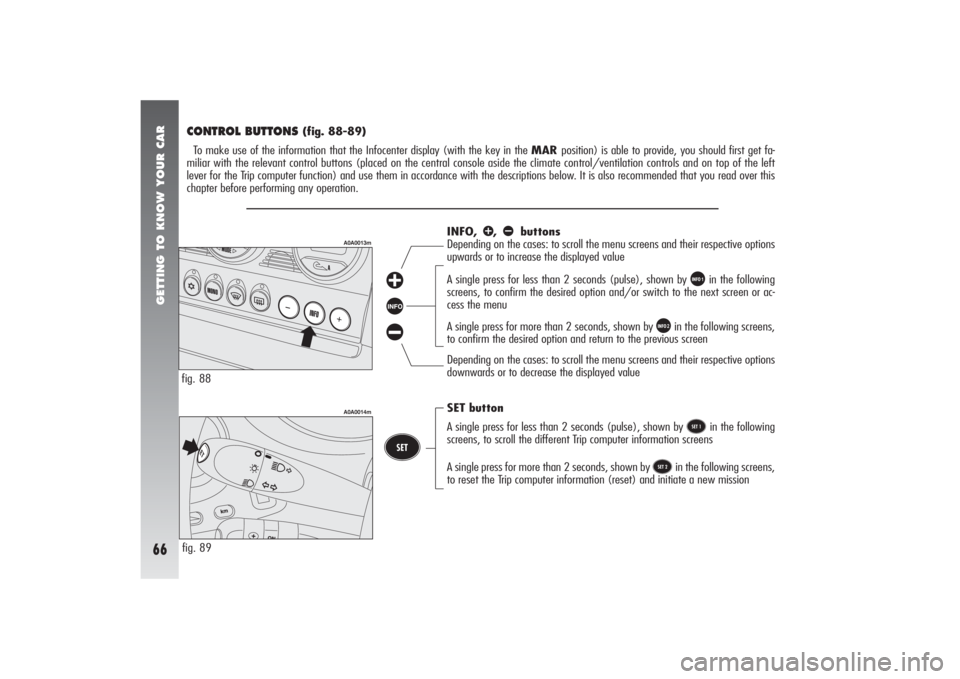
GETTING TO KNOW YOUR CAR66
CONTROL BUTTONS
(fig. 88-89)
To make use of the information that the Infocenter display (with the key in the MAR position) is able to provide, you should first get fa-
miliar with the relevant control buttons (placed on the central console aside the climate control/ventilation controls and on top of the left
lever for the Trip computer function) and use them in accordance with the descriptions below. It is also recommended that you read over this
chapter before performing any operation.
fig. 88fig. 89
ã
SET button
A single press for less than 2 seconds (pulse), shown by
ä
in the following
screens, to scroll the different Trip computer information screens
A single press for more than 2 seconds, shown by
å
in the following screens,
to reset the Trip computer information (reset) and initiate a new mission INFO,
â
, ã
buttons
Depending on the cases: to scroll the menu screens and their respective options
upwards or to increase the displayed value
Depending on the cases: to scroll the menu screens and their respective options
downwards or to decrease the displayed value A single press for less than 2 seconds (pulse), shown by
ç
in the following
screens, to confirm the desired option and/or switch to the next screen or ac-
cess the menu
A single press for more than 2 seconds, shown by
é
in the following screens,
to confirm the desired option and return to the previous screen
A0A0013m
A0A0014m
Page 70 of 357
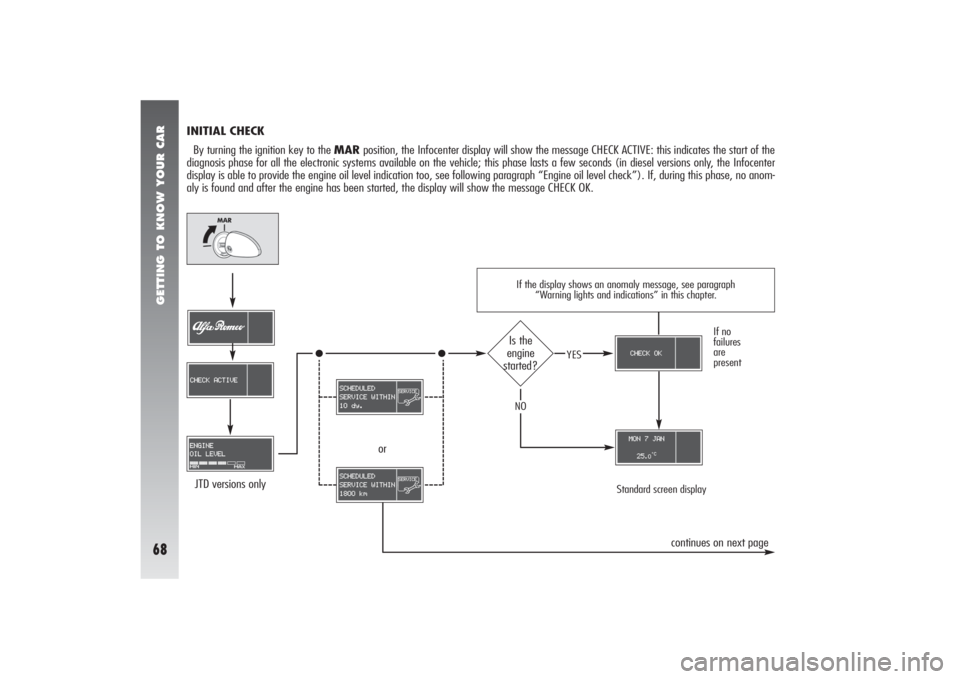
GETTING TO KNOW YOUR CAR68
If the display shows an anomaly message, see paragraph
“Warning lights and indications” in this chapter.
INITIAL CHECK
By turning the ignition key to the MARposition, the Infocenter display will show the message CHECK ACTIVE: this indicates the start of the
diagnosis phase for all the electronic systems available on the vehicle; this phase lasts a few seconds (in diesel versions only, the Infocenter
display is able to provide the engine oil level indication too, see following paragraph “Engine oil level check”). If, during this phase, no anom-
aly is found and after the engine has been started, the display will show the message CHECK OK.
Standard screen display
JTD versions only
If no
failures
are
present
Is the
engine
started?
YES
NO
or
continues on next page
Page 71 of 357
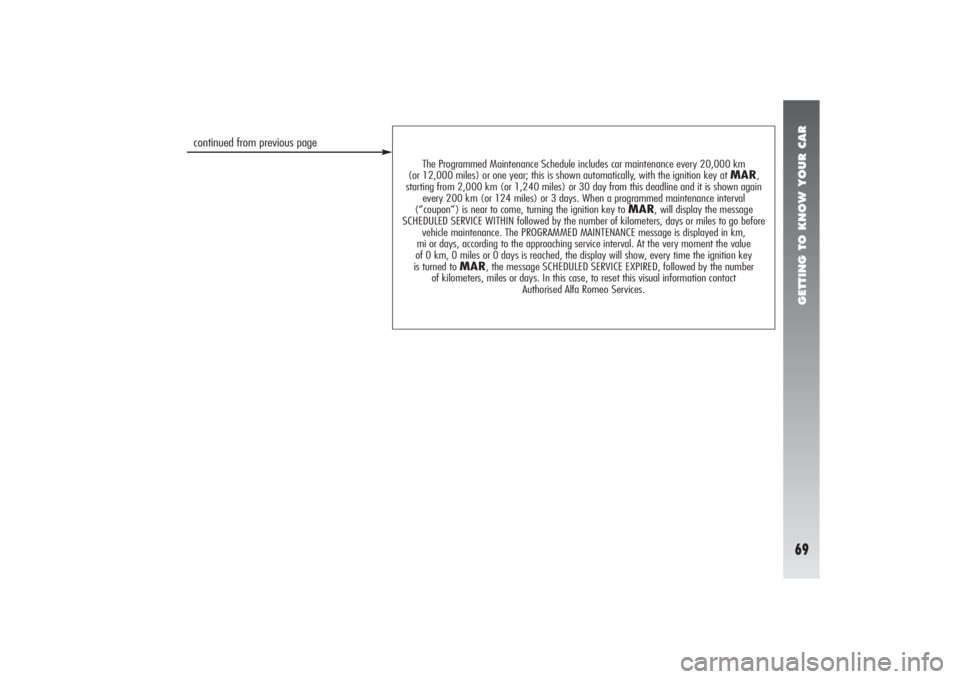
GETTING TO KNOW YOUR CAR69
The Programmed Maintenance Schedule includes car maintenance every 20,000 km
(or 12,000 miles) or one year; this is shown automatically, with the ignition key at
MAR
,
starting from 2,000 km (or 1,240 miles) or 30 day from this deadline and it is shown again
every 200 km (or 124 miles) or 3 days. When a programmed maintenance interval
(“coupon”) is near to come, turning the ignition key to
MAR
, will display the message
SCHEDULED SERVICE WITHIN followed by the number of kilometers, days or miles to go before
vehicle maintenance. The PROGRAMMED MAINTENANCE message is displayed in km,
mi or days, according to the approaching service interval. At the very moment the value
of 0 km, 0 miles or 0 days is reached, the display will show, every time the ignition key
is turned to
MAR
, the message SCHEDULED SERVICE EXPIRED, followed by the number
of kilometers, miles or days. In this case, to reset this visual information contact
Authorised Alfa Romeo Services.
continued from previous page